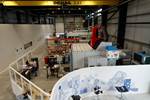Airbus to conduct studies for future moon base
Over the next 15 months, Airbus will develop a concept for a habitation and research module for a future human base in lunar orbit.
Airbus (Toulouse, France) announced Sept. 20 that the European Space Agency (ESA, Paris, France) has commissioned Airbus for two studies for possible European involvement in the future human base in lunar orbit. The Gateway, previously known as the Deep Space Gateway (DSG) or Lunar Orbital Platform-Gateway (LOP-G), is a project involving the US, Russian, Canadian, Japanese and European space agencies (NASA, Roscosmos, CSA, JAXA and ESA).
Over the next 15 months, Airbus will develop a concept for a habitation and research module as part of the first study (habitat, approximately 6.5 x 4.5 m and weighing some 9 tonnes). In the second study, Airbus will design a concept for an infrastructure element for refuelling, docking and telecommunications, which will also serve as an airlock for scientific equipment (known as Esprit, around 3 x 3 m and weighing around 4 tonnes). Both studies will be developed as part of a far-reaching European partnership.
Under NASA's (Washington, DC, US) overall design leadership, other elements – such as a second habitat, an airlock for scientific payloads and a logistics module - will be designed by international and commercial partners. NASA has plans to launch the first module - the central power propulsion element (PPE) – into lunar orbit in the early 2020s.
“The experience and know-how that ESA and Airbus have gained during flagship projects such as the Columbus space laboratory, the ATV space transporter and the European service module for Orion provide solid foundations for the studies,” says Oliver Juckenhöfel, head of On-Orbit Services and Exploration at Airbus. “When developing the new lunar platforms, robotic and human space exploration go hand in hand. Europe has a fantastic track record in both, and these two studies will help to ensure a strong European presence in future space exploration.”
Unlike the International Space Station (ISS), the Gateway is not intended to be continually inhabited. It is envisaged that the lunar platform will act as a staging point for human missions to the Moon or Mars, and testing is planned for a series of technologies and procedures that will be needed.
Airbus was unable to comment at this time on materials that are being considered as part of the ongoing study.
Related Content
-
Composite molding compound replaces Invar for lightweight small satellite structures
Patz Materials and Technologies and Lawrence Livermore National Laboratory developed a new monolithic optics housing with 80% less weight, near-zero CTE and the high-volume manufacturing required for commercial space.
-
Post Cure: Parallel winding technique demonstrates CFRP anisogrid design optimization
Over the years, CIRA has demonstrated its patented CFRP parallel winding technique in a variety of ways for space applications. The lattice structure for the Vega-C launcher stage is a prime example.
-
Composites end markets: New space (2025)
Composite materials — with their unmatched strength-to-weight ratio, durability in extreme environments and design versatility — are at the heart of innovations in satellites, propulsion systems and lunar exploration vehicles, propelling the space economy toward a $1.8 trillion future.






